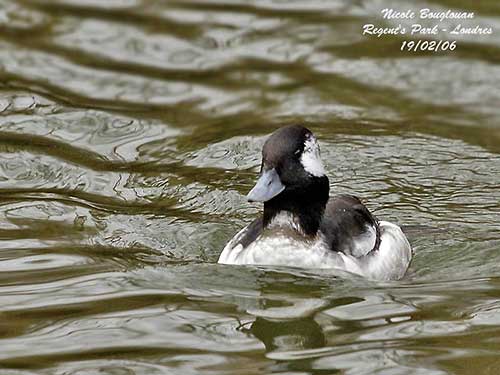Fr: Garrot albéole - Petit Garrot
Ang: Bufflehead
All: Büffelkopfente
Esp: Porrón Albeola
Ita: Quattrocchi minore
Nd: Buffelkopeend
Sd: buffelhuvud
Photographers:
Tom Grey
Tom Grey's Bird Pictures & Tom Grey's Bird Pictures 2
Ken Havard
My Bird Gallery & Flickr gallery 1 & Flickr gallery 2
Tom Merigan
Tom Merigan’s Photo Galleries
Nicole Bouglouan
Photographic ramble
Text by Nicole Bouglouan
Sources:
HANDBOOK OF THE BIRDS OF THE WORLD vol 1 by Josep del Hoyo-Andrew Elliot-Jordi Sargatal - Lynx Edicions - ISBN: 8487334105
GUIDE DES CANARDS, DES OIES ET DES CYGNES – de Steve Madge - Delachaux et Niestlé - ISBN: 2603013769
All About Birds (Cornell Lab of Ornithology)
The Birds of North America online
Animal Diversity Web (University of Michigan Museum of Zoology)
Bird Web (Seattle Audubon Society)
What Bird-The ultimate Bird Guide (Mitchell Waite)
Wikipedia, the free encyclopaedia
Bufflehead
Bucephala albeola
Anseriformes Order – Anatidae Family
INTRODUCTION:
The Bufflehead is native to North America. It breeds in the northern half of this continent, near shallow lakes and pools and in or near forested country. It winters in the southern part, on large lakes and along the coasts, often in bays and estuaries. They are monogamous. The nest is placed in cavity, often an abandoned woodpecker hole.
The Bufflehead feeds on aquatic prey such as insects, crustaceans, molluscs and small fish, and it also consumes seeds of aquatic plants. It forages mainly underwater.
The Bufflehead is usually fairly common throughout its large range, and the population is currently increasing. It is not globally threatened for the moment.
DESCRIPTION OF THE BIRD:
Biometrics:
Length: 32-40 cm
Wingspan: 53-61 cm
Weight: M: 335-600 g – F: 230-470 g
The Bufflehead adult male in breeding plumage has black upperparts including mantle, back, scapulars, tertials and rump. Lower rump and uppertail-coverts are mostly grey, and the tail is darker grey. On the black upperwing, a broad white band covers most secondaries and wing-coverts.
The underparts are white but the underwing is dark, except the white secondaries.
The head is black on crown, forehead, lores, lower cheeks, nape, chin and throat. We can see a striking green and purple gloss, but in the wild, the head appears mainly black. There is a large white patch extending from the nape and the hindneck to the crown and the rear of the eyes.
The bill is bluish-grey. The eyes are dark brown. Legs and webbed feet are pink.
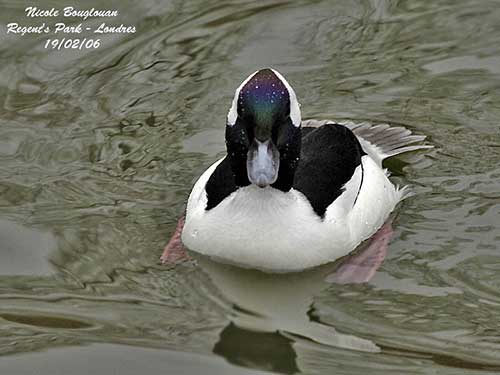
The non-breeding male resembles adult female, but the white cheek patch is larger.
The adult female has dark brown head with white oval-shaped patch on the ear-coverts. Back and tail are dark brownish-black. The upperwing is dark brownish-grey with some white secondaries.
On the underparts, breast and belly are whitish, but the flanks are brownish-grey.
The bare parts are like in male, but she has dark bluish-grey legs and webbed feet.
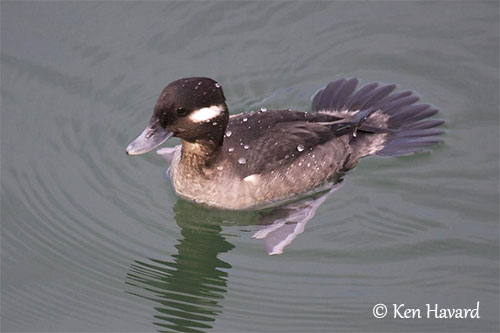
The juvenile resembles adult female but it is browner and duller, and the white cheek patch is smaller.
The 1st winter male has blacker head with larger white patch on ear-coverts. The full adult plumage is attained at about 15 months.
RANGE:
The Bufflehead breeds in the northern part of North America, from Alaska E through C Canada to Hudson Bay and Great Lakes, and S to NW USA. There are isolated populations in NW and NC USA.
It winters from S Alaska, Great Lakes and Nova Scotia, S to N Mexico.
HABITAT:
The Bufflehead breeds mainly around ponds and small lakes, usually in fairly open mixed coniferous and deciduous forests and in aspen groves. It is less often near rivers or larger lakes.
During winter, it prefers sheltered coastal habitats such as bays and estuaries, also lakes and ponds, and inland slow-moving rivers.
This species may occur up to 2,500 metres of elevation in Mexico.
CALLS AND SONGS: SOUNDS BY XENO-CANTO
The Bufflehead male produces a loud, raspy noise during the courtship displays. In late winter and spring, it utters low snarling grunts.
During the displays, the female produces a loud, deep throaty sound while following the male. She also gives low notes to call her young, and when alarmed, these notes speed up and become louder.
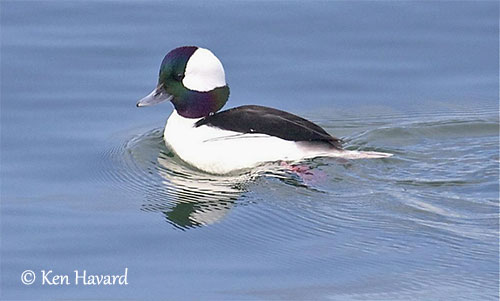
BEHAVIOUR IN THE WILD:
The Bufflehead feeds primarily on aquatic invertebrates and some seeds. Insects include larvae of damselflies, dragonflies, midges, mayflies, caddisflies and other insect species. In coastal habitats, it feeds on arthropods and molluscs, fish eggs and some small fish.
In the fall, it feeds on seeds from several aquatic plants species. During the incubation, numerous females feed on gastropods, a probably well-adapted food during this period.
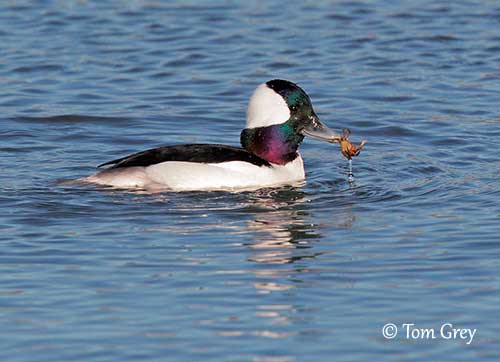
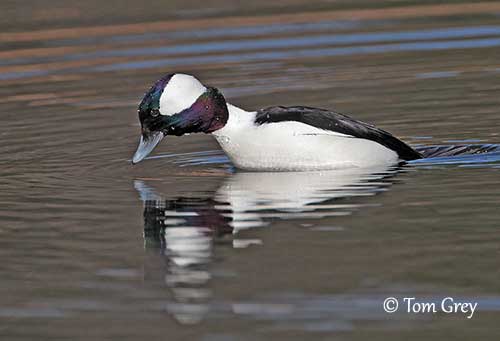
The courtship displays start by early winter, but the pairs form usually in spring.
During the displays, the male performs head-bobbing, wing-lifting and also some short display flights, usually with fully raised crest feathers.
The female nests in cavity, often in abandoned Pileated Woodpecker hole in tree.
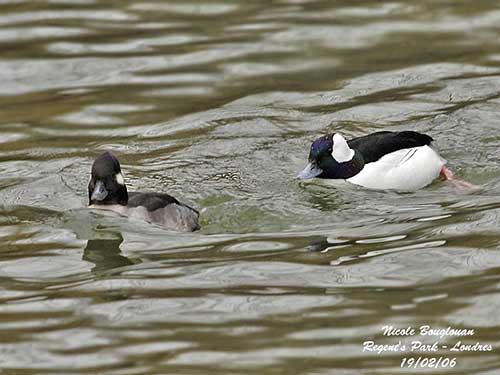
The Bufflehead is migratory and usually moves late in fall. But initial movements to moulting occur in June/July and the males first. Then, they move to their wintering grounds in October/November. They return in March/April, the adults first.
While migrating over land, they fly in small flocks and mainly at night.
The flight is swift and direct with rapid wingbeats. The Bufflehead takes off by flying straight up from the water. It flies low over water and higher over land.
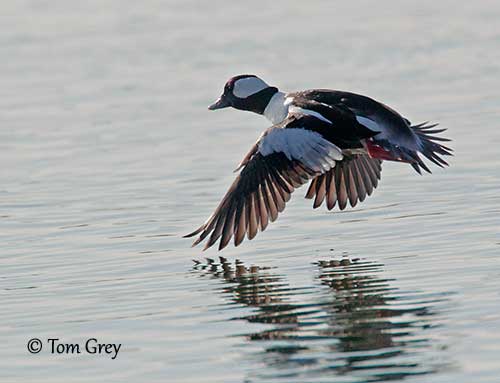
REPRODUCTION OF THIS SPECIES:
The breeding season starts in late April/early May, when the breeding range becomes ice-free.
The Bufflehead nests in cavities, usually a hole in tree, and especially old woodpecker holes. This cavity may be between 3 and 15 metres above the ground. Nest-boxes are accepted too.
The nest is lined inside only with down. It may be reused for several following years.
The female lays 8-10/6-12 pale buff eggs. She incubates alone during 29-31 days (28-33). The chicks leave the nest very soon after hatching, usually within one or two days. The female leads them to the water where they feed themselves by dabbling. They can fly 50-55 days after hatching. They become quickly very good swimmers.
The territory is aggressively defended by the male until the chicks hatch. Then, it leaves the breeding grounds for moulting, while the female cares and defends the brood alone.
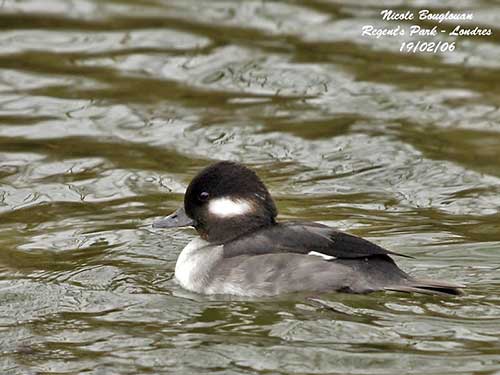
PROTECTION / THREATS / STATUS:
The Bufflehead is described as fairly common throughout the large range.
Following intense hunting pressure in 20th century, and loss of nesting habitat, the population has recovered and is currently increasing. It was estimated to number 1,200,000 individuals in 2006.
The Bufflehead is not globally threatened, and currently evaluated as Least Concern.
